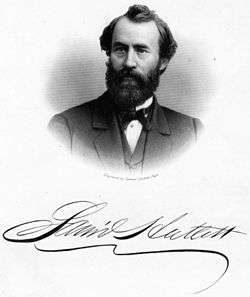Samuel Hallett


Samuel Hallett (1827-July 27, 1864) was an American railroad developer, particularly known for the initial development of the eastern branch of the Union Pacific Railroad.
Hallett was born in Canisteo, New York. In 1848 he married Ann Elizabeth McDowell of Wayne, New York, sister to Francis M. McDowell. Hallett and the McDowell brothers, along with Civil War General Nirom Crane, engaged in a number of enterprises including the Hallett & Co. Bank in New York City. In 1854 he built a large mansion in his wife's home town, known as the "Hallett House" or "The Aisle of Pines". He unsuccessfully ran for congress in 1856.
In 1863 Hallett’s firm, in association with John C. Fremont, bought the controlling interest in the Leavenworth, Pawnee and Western railroad. This line became the Union Pacific Eastern Division and then the Kansas Pacific Railway. They soon ran short of money and Hallett went before Congress to get additional funds for the road. After a dispute with Hallett, Fremont withdrew but Hallett took over and continued construction of the Kansas link of the railroad to the Pacific.
The process of building the railroad was highly political, and in the political maneuvering, Hallett came into conflict with the chief engineer of the Kansas Pacific, Orlando A. Talcott. Talcott, in a letter to president Abraham Lincoln, accused Hallett of substandard construction of the railroad. This letter was referred to the interior secretary John Palmer Usher who was a close friend of Hallett, and so Hallett was informed of Talcott's letter. As a result, Talcott was physically assaulted by one of Hallett's brothers in Wyandotte, Kansas (across the Kansas River from Kansas City, Kansas). On July 27, 1864, Talcott retaliated by shooting Samuel Hallett dead in the streets of Wyandotte.
References
- Perl W. Morgan, ed. (1911). History of Wyandotte County Kansas and its people. Chicago, IL: The Lewis publishing company. Retrieved 2007-10-18.
- David Haward Bain (1999). Empire Express: Building the First Transcontinental Railroad. New York, NY: Penguin publishing company. ISBN 0-670-80889-X.
- Taylor, David G. (1976). "Thomas Ewing, Jr., and the Origins of the Kansas Pacific Railway Company". Kansas Historical Quarterly. Kansas State Historical Society. 42 (2). Retrieved 2007-10-18.
- Rowland, Donald A. (May 1989). "The Aisle of Pines". The Crooked Lake Review. Hammondsport, NY: Martha and William Treichler (33). Retrieved 2007-10-18.